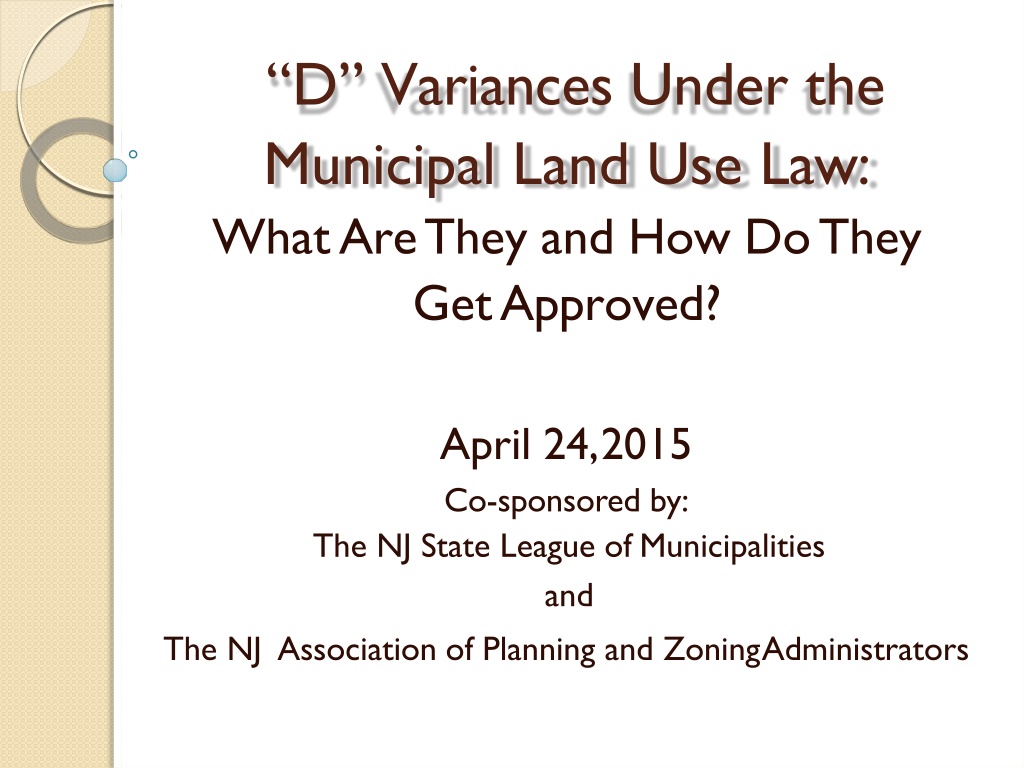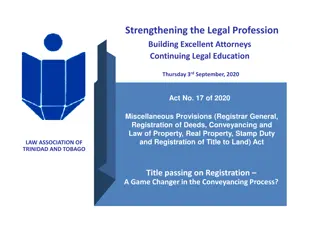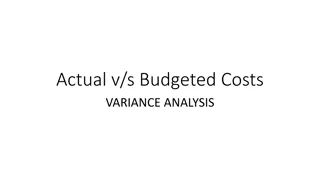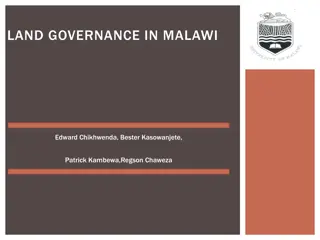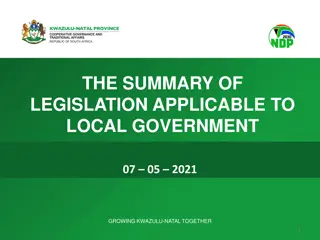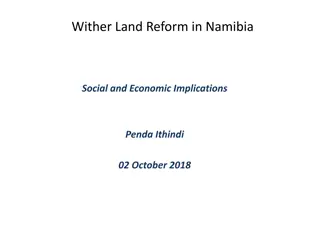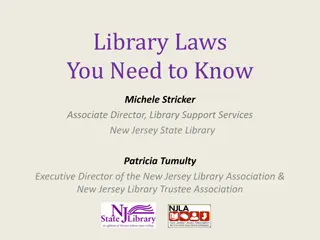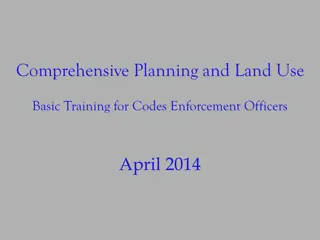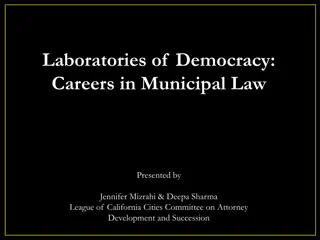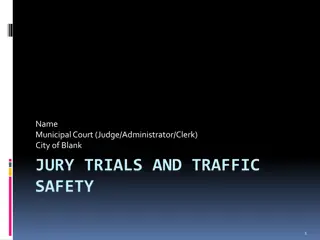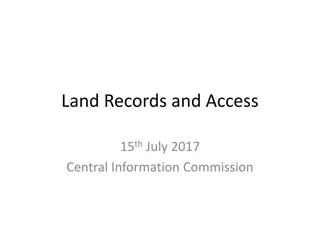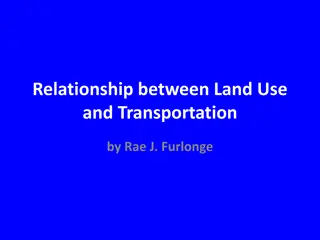Understanding D Variances Under Municipal Land Use Law
Exploring D variances under the Municipal Land Use Law (MLUL) in New Jersey, including their origin, approval process, and the role of the Zoning Board of Adjustment. D variances provide relief from zoning regulations and are granted by the Zoning Board of Adjustment for special reasons. The Zoning official plays a key role in the variance process, although a zoning permit may not always be required.
Download Presentation

Please find below an Image/Link to download the presentation.
The content on the website is provided AS IS for your information and personal use only. It may not be sold, licensed, or shared on other websites without obtaining consent from the author. Download presentation by click this link. If you encounter any issues during the download, it is possible that the publisher has removed the file from their server.
E N D
Presentation Transcript
D Variances Under the Municipal Land Use Law: What Are They and How Do They Get Approved? April 24,2015 Co-sponsored by: The NJ State League of Municipalities and The NJ Association of Planning and ZoningAdministrators
Presenters: SUSAN RUBRIGHT,ESQ. AND PETER STECK,PP
What are dvariances? They are a form of relief from a provision of a local zoning ordinance as permitted under the Municipal Land Use Law (MLUL) in NJSA 40:55D-70d NJSA stands for New Jersey Statutes Annotated
What is the Municipal Land Use Law? It is enabling legislation telling which powers of the State are being given to municipalities. All zoning powers are held by the State except for those that the State chooses to give to municipalities. 40:55D-1 Short title This act may be cited and referred to as the "Municipal Land Use Law."
Where does d varianceoriginate? The d refers to 70d in thecitation 40:55D-70 Powers The board of adjustment shall have the power to . d. In particular cases for special reasons grant a variance to allow departure from regulations pursuant to article 8 of this act .
Which board can grant them? A d variance is a bigdeal. Only the Zoning Board of Adjustmentcan grant a d variance and it requires five affirmative or yes votes forapproval. The standards of proof are tougher because the granting of a d variancecan do more damage to a municipality.
What is the role of the zoning official in the d varianceprocess? In most municipalities the zoning official is the administrative officer responsible for issuing zoning permits in accordance with NJSA 40:55D-7.
What is the role of the zoning official in the d varianceprocess? (cont d) A zoning permit is not statutorily required but may be required by local ordinance prior to the commencement of a use or the erection, construction reconstruction, alteration orconversion of a building or structure.
What is the role of the zoning official in the d varianceprocess? (cont d) As part of the application review process, the zoning official compares the submission to the zoning ordinance requirements prior to issuing a zoning permit. When the zoning official determines that the ordinance requirements are NOT met, s/he directs the applicant to the appropriate board to seek any needed variances.
What is the role of the zoning official in the d varianceprocess? (cont d) There should never be an instance where an application goes to both the Planning Board and the Zoning Board of Adjustment. Where a d variance is involved,the Zoning Board of Adjustment has sole jurisdiction.
DVARIANCES STEP BY STEP
40:55D-70d. In particular cases and for special reasons, grant a variance toallow departure from regulations pursuant to article 8 of this act to permit: Article 8 is the zoning article of the Municipal Land Use Law. It describes what zoning powers have been given to municipalities. A variance is a request for relief that relates only to a provision of in the Zoning Ordinance.
Determining where a d provision is located in your development ordinance. The zoning ordinance definitions are key to determining whether an application involves a permitted use. What if you have a separate definition section in your land development ordinance and those definitions apply to all of the zoning, subdivision and site planstandards?
Under NJSA 40:55D-70d, the Board of Adjustment maygrant six different types of variances:
The d(1)Variance A use or principal structure in a district restricted against such a use or structure A zoning ordinance typically lists the uses and principal structures permitted in each zoning district.
The d(1) Variance(contd) Note that d(1) says a use orprincipal structure An application involving an accessory structure that is not permitted in the zone does not rise to the level of a d(1) variance.
The d(2)Variance An expansion of an existing nonconforming use MLUL definition: "Nonconforming use" means a use or activity which was lawful prior to the adoption, revision or amendment of a zoning ordinance, but which fails to conform to the requirements of the zoning district in which it is located by reasons of such adoption, revision oramendment. 19
Permitted/Prohibited Uses How should the zoning official proceed if s/he is unsure about the proposed use and the zoning definitions provide no guidance?
The d(3)Variance deviation from a specification or standard pursuant to section 54 of P.L.1975,c.291 (C.40:55D-67) pertaining solely to a conditional use MLUL Definition: "Conditional use" means a use permitted in a particular zoning district only upon a showing that such use in a specified location will comply with the conditions and standards for the location or operation of such use as contained in the zoning ordinance,and upon the issuance of an authorization therefor by the planning board.
Conditional Use Standards Every conditional use identified in the zoning ordinance should have one or more objective, measurable standard which the application must meet in order to qualify as a permitted use in the zone. 22
The d(4)Variance an increase in the permitted floor area ratio as defined in section 3.1 of P.L.1975, c.291 (C.40:55D-4) MLUL Definition: "Floor area ratio" means the sum of the area of all floors of buildings or structures compared to the total area of land that is the subject of an application for development, including noncontiguous land, if authorized by municipal ordinance or by a planned development.
Floor Area RatioCalculation The floor area ratio (FAR) is calculated by dividing the total floor area by the total land area. Example: A two-story building has 2,500 sq. ft.on each floor, for a total floor area of 5,000 sq. ft. The building sits on a lot that is 8,000 sq.ft.. The FAR calculation is:5,000/8,000=0.625.
The d(4) Variance(contd) An FAR of 0.25 means that the floor area on a one acre lot can be up to of an acre or the floor area of a 10,000 square foot lot can be up to and including 2,500 square feet. if an application is over the maximum floor area by only a small amount, itstill becomes a d(4) variance.
The (d)5 Variance an increase in the permitted density as defined in section 3.1 of P.L.1975,c.291 (C.40:55D-4), MLUL Definition: "Density" means the permitted number of dwelling units per gross area of land that is the subject of an application for development, including noncontiguous land, if authorized by municipal ordinance or by a planned development.
The (d)5 Variance (contd) except as applied to the required lot area for a lot or lots for detached one or two dwelling unit buildings, which lot or lots are either an isolated undersized lot or lots resulting from a minor subdivision. This MLUL language provides exemptions to the (d)5 variance standards in certain small-scale subdivision situations
Density Calculation In general, the applicant s engineer should provide data indicating how the proposed development meets the zoning district standards. However, the planner or zoning official should always review the figures provided to confirm compliance.
Density Calculation (contd) Dwelling units per acre the total units are divided by the total site acreage to calculate the units per acre, andthat number is compared to the zone requirement. Example: the zoning ordinance specifies a maximum density of 6 units per gross acre. The development proposal shows 16 single-family dwelling units on 4 acres of land, so the gross density is 16/4= 4 units per acre. Therefore,the plan complies with the ordinance s density requirement.
Density Calculation (contd) Minimum lot size Example: If the zoning ordinance specifies a minimum lot size of 8,000 sq. ft., then the maximum density can be calculated as follows: 43,560 sq. ft per acre/8,000 min.lot size =5.4 dwelling units per acre
The (d)5 Variance (contd) As with the floor area ratio, even a little bit over the maximum permitted density triggers a d(5) variance. 32
The d(6) Variance An increase in the height of a principal structure that exceeds the maximum height permitted in a zoning district by 10 feet or 10 percent Height is not defined in the MLUL, so how height is measured depends on the language in municipal ordinances. 33
The d(6) Variance (contd) This provision applies only to principal structures. It does not apply to accessory structures. If either the 10 foot provision or the 10% provision is violated, it triggers a d(6) variance.
Height Calculation Municipal zoning ordinances can vary widely in their definitions of building height, so the zoning official must be familiar with the local standards. T o determine whether an application complies with the ordinance, thezoning official has to be familiar with not only where the height measurement is taken but also various roof styles.
PROOFS REQUIRED FOR GRANTING A D VARIANCE 37
The Positive Criteria Special Reasons NJSA 40:55D-70d states that in particular cases and for special reasons . the types of variances already identified may be granted by the Board ofAdjustment. These special reasons also are referredto as the positive criteria. Most broadly, the applicant must prove that a project advances one of the 16 purposes of zoning listed in the MLUL at NJSA 40:55D-2. 38
The Positive Criteria (contd) Special Reasons (cont d) As an alternate rationale, extreme or undue hardship can exist where a condition of the land results in economic inutility, and the property cannot reasonably be used for its zoned purpose. 39
The Positive Criteria (contd) Special Reasons (cont d) Inherently Beneficial Uses NJSA 40:55D-4 defines an inherently beneficial use as one which is universally considered of value to the community because it fundamentally serves the public good and promotes the general welfare. If a use is held to be inherently beneficial,it presumptively satisfies the positive criteria. 40
The Positive Criteria (contd) Special Reasons (cont d) The site suitability test established through two NJ Supreme Court cases further refines the special reasons requirements for uses that are not inherently beneficial. 41
The Positive Criteria (contd) Special Reasons (cont d) Kohl v. Mayor and Council of Fair Lawn established the principle that the use must promote the general welfare by being particularly fitted tothe particular location for which the variance is sought. Medici v. BPR Co. established the requirement for an enhanced quality of proof and the applicant s need to show that there has been substantial change in the character of the community since the adoption of the master plan and zoning ordinance. 42
The Negative Criteria NJSA 40:55D-70 states that Novariance or other other relief may be granted under the terms of this section without a showing that such variance or other relief can be granted without substantial detriment to the public good and will not substantially impair the intent and purpose of the zone plan and zoning ordinance. 43
The Negative Criteria (contd) Without substantial detriment to the public good What are the impacts on the surrounding properties? It is up to the Board of Adjustment to determine whether any negative impacts on the surrounding neighborhood are so severe as to be substantial. 44
The Negative Criteria (contd) Will not substantially impair the intent and purpose of the zone plan and zoning ordinance The zone plan is the masterplan The intent and purpose of the master plan is found with the master plan language. 45
